
USS Coronado (AGF-11) was the second ship of the United States Navy to be named after the city of the same name in the U.S. state of California. She was designed as an Austin-class amphibious transport dock (LPD), one of seven fitted with an additional superstructure level for command ship duties. The ship was launched on 1 July 1966, commissioned 23 May 1970, and became the most advanced command ship in the world. The ship was the second combatant ship in the United States Navy to integrate women as full-time crew members.

USS Ponce, is an Austin-class amphibious transport dock, formerly in service with the United States Navy. She has been the only ship of the Navy named for Ponce in the Commonwealth of Puerto Rico, which in turn was named after the Spanish explorer Juan Ponce de León, the first governor of Puerto Rico and the European discoverer of Florida. Her keel was laid down on 31 October 1966 by the Lockheed Shipbuilding and Construction Company of Seattle, Washington. She was launched on 20 May 1970 sponsored by Florence W. Hyland, the wife of Admiral John J. Hyland, and commissioned on 10 July 1971. She spent most of her career based on the East Coast and operating in the Atlantic Ocean and Mediterranean Sea, serving in Operation Desert Shield and supporting US operations in the 2011 Libyan Civil War.

USS Vandegrift (FFG-48) was an Oliver Hazard Perry-class frigate of the United States Navy. The ship was named for General Alexander A. Vandegrift (1887–1973), 18th Commandant of the Marine Corps.

USS Higbee (DD/DDR-806) was a Gearing-class destroyer in the United States Navy during World War II. She was the first U.S. warship named for a female member of the U.S. Navy, being named for Chief Nurse Lenah S. Higbee (1874–1941), a pioneering Navy nurse who served as Superintendent of the U.S. Navy Nurse Corps during World War I.
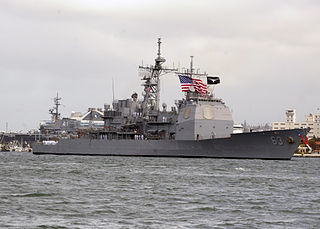
USS Cowpens (CG-63) is a Ticonderoga-class guided missile cruiser in service with the United States Navy. The ship is named after the Battle of Cowpens, a major American victory near Cowpens, South Carolina, in the American Revolution. She was built at the Bath Iron Works in Maine. Cowpens is stationed at Naval Base San Diego.
A destroyer squadron is a naval squadron or flotilla usually consisting of destroyers rather than other types of vessel. In some navies other vessels, such as frigates, may be included. In English the word "squadron" tends to be used for larger and "flotilla" for smaller vessels; both may be used for destroyer units. Similar formations are used in non-English-speaking countries, e.g., the "escadrille"—which would translate directly as "squadron"—in France.

USS Thach (FFG-43), an Oliver Hazard Perry-class frigate, was the only ship of the United States Navy named for Admiral John Thach, a Naval Aviator during World War II, who invented the Thach Weave dogfighting tactic.
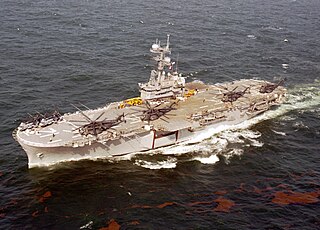
USS Inchon (LPH/MCS-12) was an Iwo Jima-class amphibious assault ship of the United States Navy in service from 1970 to 2002. Following a major fire, she was laid up and sunk as a target in 2004.

USS Comstock (LSD-45) is a Whidbey Island-class dock landing ship of the United States Navy. She was the second Navy ship to be named for the Comstock Lode in Nevada, the first being Comstock (LSD-19), commissioned in 1945 and decommissioned in 1976. The Comstock Lode was discovered in 1859, and was one of the richest deposits of precious metals known in the world.

Naval Station Ingleside was a United States Navy base in Ingleside, Texas.
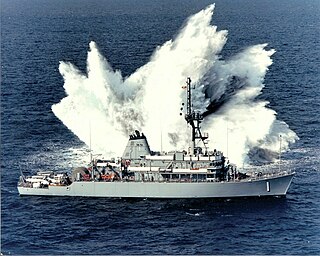
USS Avenger (MCM-1) was the lead ship of her class of mine countermeasures ship, and the third U.S. Navy ship of that name.
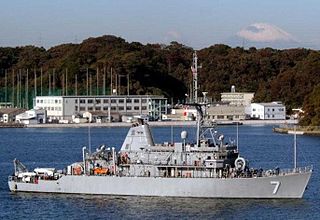
USS Patriot (MCM-7), is an Avenger-class mine countermeasures ship of the United States Navy, and is the third Navy ship of that name. The hulls of the Avenger-class ships are constructed of wood with an external coat of fiberglass.
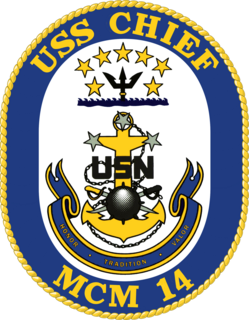
USS Chief (MCM-14) is an Avenger-class mine countermeasures ship of the United States Navy. She was named for the former USS Chief (AM-315), which in turn was named in honor of all chief petty officers of the US Navy.

USS Raven (MHC-61), an Osprey-class coastal minehunter, was the third ship of the United States Navy to be named for the raven. The contract to build her was awarded to Intermarine USA in Savannah, Georgia on 31 March 1993 and her keel was laid down on 1 April 1995. She was launched on 28 September 1996, and commissioned on 5 September 1998.
USS Targeteer was an LSM(R)-501-class landing ship medium (rocket) originally projected as LSM-508. The landing craft was reclassified as LSM(R)-508 in February 1945 and laid down on 31 March 1945 at Houston, TX, by the Brown Shipbuilding Corporation. Launched on 28 April 1945, LSM(R)-508 was commissioned at Houston on 25 June 1945, Lieutenant Harry E. Montgomery, USNR, in command.
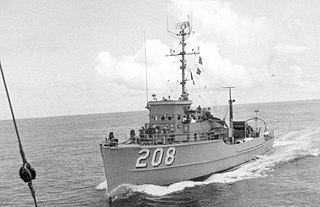
USS Widgeon (AMS/MSC-208) was a Bluebird-class minesweeper acquired by the US Navy for clearing coastal minefields.

USS Defender (MCM-2) was an Avenger-class mine countermeasures ship in the service of the United States Navy. She entered service in September 1989 and was decommissioned in October 2014.

USS Champion (MCM-4), an Avenger-class mine countermeasures ship, is the fourth U.S. Navy ship of that name.

USS Mount Vernon (LSD-39) was an Anchorage-class dock landing ship of the United States Navy. She was the fifth ship of the U.S. Navy to bear the name. She was built in Massachusetts in 1972 and homeported in Southern California for 31 years until being decommissioned on 25 July 2003. Mount Vernon acted as the control ship for the cleanup of the Exxon Valdez oil spill. In 2005, she was intentionally destroyed off the coast of Hawaii as part of a training exercise.

The fourth USS Scout (MCM-8) is an Avenger-class mine countermeasures ship of the United States Navy.




















